Welcome to Natural Wonders, where I hope to pique your interest each week by sharing some fascinating questions and answers about natural phenomena. If you’re new here or if someone forwarded you this email, you can subscribe below.
Check out past posts by going here and see who I am and what Natural Wonders is about here.
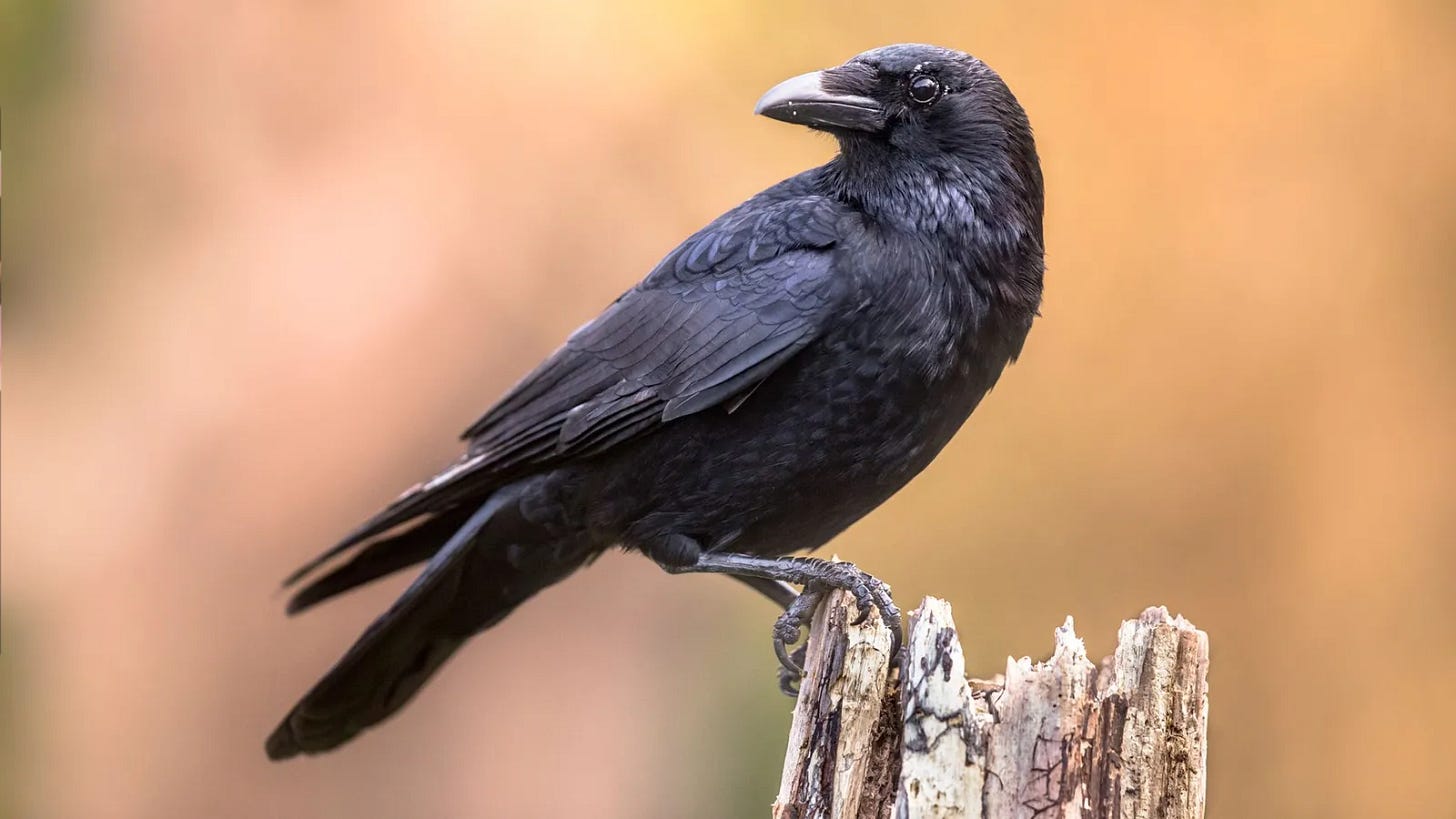
This week’s question comes from a reader, Joe, who is an artist and overall observant person. Here’s what he said:
Recently walking a country road, I encountered some crows sitting in the road. Naturally they flew away. One lit on the very top of a small pine. I was amazed how the small needles supported him. He would call out "caw,caw,caw" seems like an answer would follow from another location. It seemed like different combinations of calls would follow with different intensity.
I recall as a child the local farmers would gather at spring planting time and fall harvest to have a crow hunt. They would use different types of devices made of bamboo or other materials, by blowing through them would imitate the sound of the crows. (Crow calls)
The crows would flock toward these sounds to be shot at by the hidden farmers. They would hang their kill on the pasture fence for other crows to see hoping to keep them out of the fields.
Many times, I have heard crows gather in the woods around a nest when the young birds would learn to fly. It sounded like a good time was had by all!
Joe wondered about crow communication – are they especially good at communicating? Do they warn each other when humans are nearby? Do they post sentinels to watch for danger? Do they “talk” to their young to encourage them out of the nest?
Joe’s story reminded my husband, Andrew, about an incident from his childhood. He was in 2nd grade and got the grand idea to build a bird blind with his younger brother and try out his dad’s crow call. They tied together privet hedge into a dome shape, weaving in more saplings until they were well-hidden. The next day Andrew went alone to the blind with the crow call. He remembers trying out a variety of crow calls until a few crows showed up.
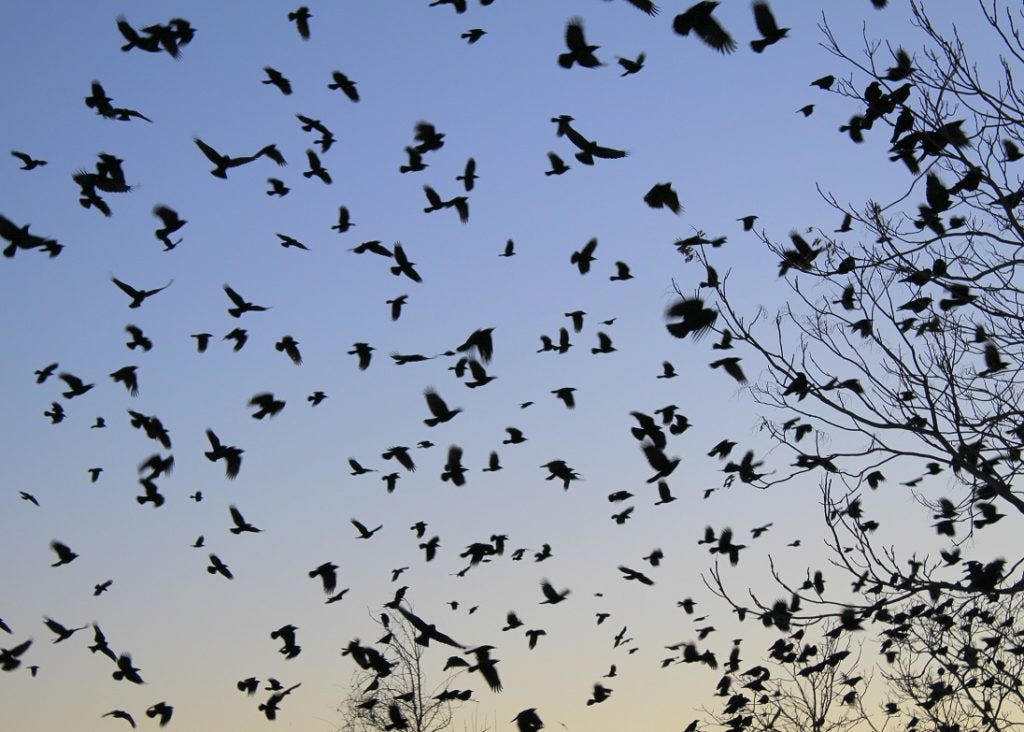
They called back to him and then more crows arrived. Then more, and more, and more crows came until he was surrounded by a cloud of black crows, raucously calling to each other, diving, landing, and flying all around him. He can’t remember how he got away, but distinctly remembers being terrified.
So, what’s going on with crows and how they communicate?
The first thing I learned is that crows are extremely intelligent. In this Ted Talk, scientist John Marzluff explains that, like primates, crows have bigger brains than other animals of their size. Also like us, they have an amygdala for processing emotions and two brain hemispheres. Because of this, he refers to crows as “small flying monkeys.” Interestingly, their brain hemispheres aren’t as well-connected to each other as ours and thus they sometimes use one side while allowing the other side to sleep.
Their large brains mean they are able to consider and reconsider thoughts – not just react to a stimulus, but consider whether to act on it. For instance, they’ve been known to use tools solve problems of how to get insects and grubs out of hard-to-reach places, even bending the tool into a hook when needed.

One fascinating study taught a crow, appropriately named 007, to use a series of tools to solve a puzzle. This crow used a combination of tools in an 8-step problem to get at a piece of food. First, he had to extract a short stick from a knot by pulling up a string; then, he used that stick to pull three stones out of separate cages. Those stones each had to be dropped into a chute that flipped a door, releasing a longer stick which could then be used to pull a piece of meat out of a larger cage. You can watch him in action here:
Crows are also very social and live in extended family groups. The young stay with their parents for at least a year, helping to raise the next year’s young. This might be why Joe saw birds gathered around a nest – last year’s young help feed the nestlings and stand guard as they grow. They even feed the babies for 2 weeks after they’ve left the nest because they can’t quite yet fly and are vulnerable to predators during that time.
Because they’re very social, crows learn from each other’s mistakes. One way they do this? They hold funerals for their dead. When a crow dies, other crows gather around in the nearby trees. Some have prolonged silent vigils. Some bring “gifts” like sticks or candy wrappers to the dead crow. They call to each other and observe the area for about 20 minutes or so before flying off together. This scenario has only been observed with dead crows – dead sparrows and other birds don’t initiate this type of behavior. PET scans of crows as they’re shown a dead crow indicates the “learning” part of the brain lights up, rather than the “emotional” side. Scientist think the crows are studying the situation and trying to learn from it so they can prevent the same fate from happening to them.
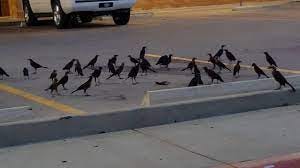
The result is that crows often avoid an area where a previous funeral has been held for months or even years. This is likely why farmers use the crow calls to attract and then shoot crows to hang on the fence like Joe mentioned above. This deterrent apparently works much better than using a scarecrow – crows are intelligent enough that they easily become comfortable with scarecrows unless they are constantly moved to new locations or altered every few days.
Crows live 20-30 years and during that time they accumulate a great deal of knowledge from each other due to their social nature. For instance, scientists have found that crows can recognize the faces of specific people, even many years after they first encounter them. Scientists tested this by wearing an ugly caveman mask to capture crows and put them into cages. They then wore a Dick Cheney mask during other times when they acted neutrally with the crows. From then on, whenever the crows saw someone with the caveman mask they scolded and divebombed that person. Even if the person wore the mask upside down or with a hat. Eight years later, crows were still harassing the caveman-mask wearing scientists. By that time, many of the scolding birds hadn’t even been born during the original experiment – they had learned the behavior from their crow family.


Because of their intelligence and sociability, crows have evolved to have a wide vocabulary in their language. Their calls consist of caws, rattles, croaks, and more. Crow language is like Mandarin or Vietnamese, which are tonal languages, meaning the same word can mean different things depending on the emphasis put on different parts or the speed with which it is spoken.
If you pay attention, you can hear the emotion in a crow’s call. If they’re just saying a neighborly greeting as they pass another group of crows at sunset, their calls will sound much more relaxed than when they spot a hawk or fox and are warning the others. The rattle sound crows make is an intimate sound they usually only use with family members. They might also just rattle to themselves if they’re lonely.
Crow calls can be contextual, meaning they’re responding to something in the environment, like a predator or a neighboring flock of crows, or they can be non-contextual, meaning there’s no discernible reason for their making sounds. In these cases, they might just simply be letting other crows know where they are, sort of like a roll call of attendance.
Crows are known to be protective of their areas and even aggressive to predators. Many times, they chase off predators by “mobbing” them, meaning they make many overlapping calls as a way to harass the predator, even going so far as to divebomb them. Quite often you’ll see a few crows harassing a hawk or owl as it tries to fly away.
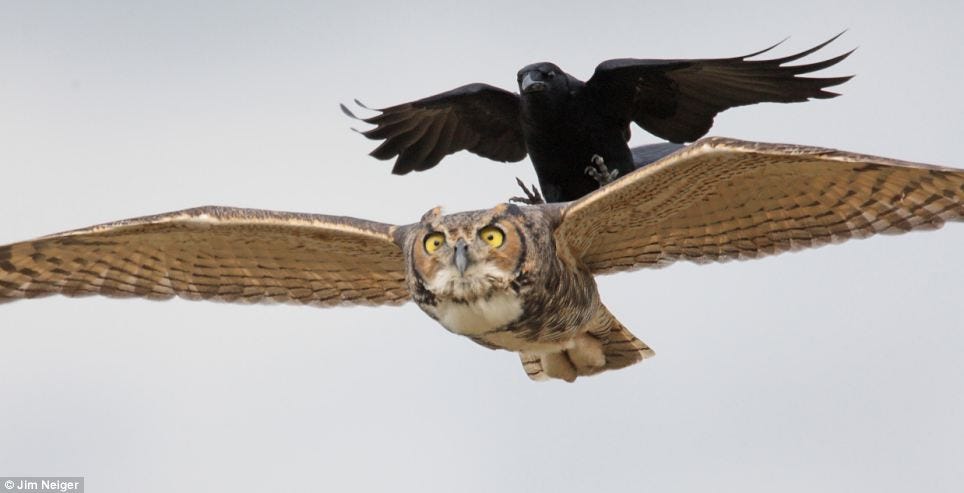
This aggressive behavior may have something to do with why a group of crows isn’t called a “flock” but is instead known as a “murder,” as in, “The field was picked clean by a murder of crows.” That term reflects the generally negative attitude people have towards crows, viewing them as a nuisance species.
This mobbing behavior is probably what Andrew experienced as a 7-year-old in his bird blind. Either the crows realized he was in interloper hidden in their territory or he had inadvertently used some pretty harsh crow language with his crow call.
All in all, it does seem like crows have a special ability to communicate. It’s mainly due to their high intelligence, but also because they live in social groups and have evolved to work together. Joe was right to notice their tendency to talk and congregate together, guard against humans, and chat with their young. On the other hand, Andrew learned to never underestimate the power of a crow call.
What have you observed about crows? Have you witnessed any intelligent behavior by them? What about aggressiveness? Have you been lucky enough to see a crow funeral? Tell us what you’ve seen!
Nature break: Go for a walk in the woods. Find a quiet place to sit still and just listen for bird calls. Do they seem to be communicating with each other? Are they alarmed about your presence or just taking roll call? How many different calls can you identify?
Weird Nature:
Detritus
Crows belong to the group of birds called corvids - crows, ravens, magpies and jays. Corvids are intelligent and talkative, and have been taught to speak English (and also Russian and German). Fable the Raven has a clear vocabulary and in this video you can hear her talking to herself on a hidden camera as she practices her English.
Since traditional scarecrows don’t really work without a lot of effort to keep them fresh and interesting, enterprising humans have invented a digital scarecrow that use ultrasonic waves to scare off crows and other animals it can detect with its infrared sensor.
Crows will sometimes participate in “anting,” which is like a dirt bath but with ants. They flop around in an ant bed until the ants swarm all over them. Scientists aren’t sure why they do this, but one theory is that the ants secrete chemicals that act as insecticides and the crows “borrow” these to kill off mites. Another theory is that crows use the ants as a sort of “after-shave” to leave their skin feeling tingly after molting.
If you’re enjoying this newsletter, please take a moment and share it with two of your friends you think would enjoy it too. Or just click the “like” button at the bottom - that always warms my heart!
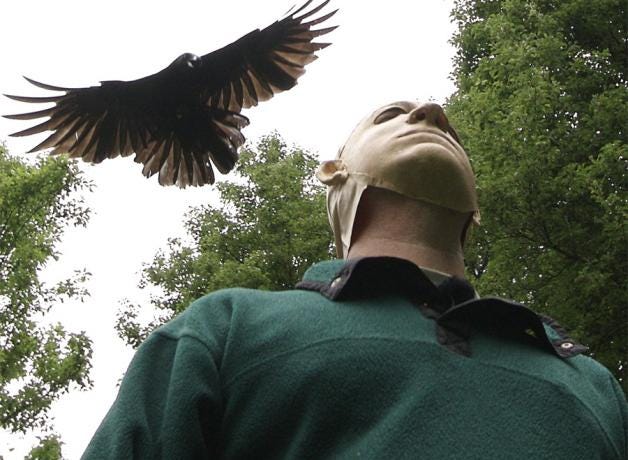





Subscribed!
What amazing birds. They have funerals? That's just incredible. I knew they were intelligent and recognised faces, but there's a lot more to them than I ever knew